Papers by Frank Mastaglia
Journal of Experimental Stroke and Translational Medicine, 2009
The restricted ability of most proteins and peptides to cross the blood-brain barrier and/or plas... more The restricted ability of most proteins and peptides to cross the blood-brain barrier and/or plasma membrane limits their use as therapeutics following cerebral ischaemia. However, the discovery of cell-penetrating peptides has provided a means by which such molecules can be transported across the blood-brain barrier and plasma membrane. Many proteins/peptides have already been shown to have neuroprotective properties, and, due to their ability to block protein-protein interactions, provide a potentially rich source of new therapeutic compounds to prevent cell death following cerebral ischaemia. In this review, we give an overview of cellpenetrating peptides and their use experimentally to deliver neuroprotectant proteins/peptides into the brain following cerebral ischaemia.
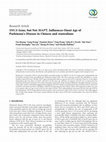
BioMed Research International, 2015
Background.α-Synuclein (SNCA) and microtubule-associated protein tau (MAPT) are the two major gen... more Background.α-Synuclein (SNCA) and microtubule-associated protein tau (MAPT) are the two major genes independently, but not jointly, associated with susceptibility for Parkinson’s disease (PD). TheSNCAgene has recently been identified as a major modifier of age of PD onset. WhetherMAPTgene synergistically influences age of onset of PD is unknown.Objective. To investigate independent and joint effects ofMAPTandSNCAon PD onset age.Methods. 412 patients with PD were recruited from the Australian PD Research Network (123) and the Neurology Department, Ruijin Hospital Affiliated to Shanghai Jiaotong University, China (289).MAPT(rs17650901) tagging H1/H2 haplotype andSNCA(Rep1) were genotyped in the Australian cohort, andMAPT(rs242557, rs3744456) andSNCA(rs11931074, rs894278) were genotyped in the Chinese cohort. SPSS regression analysis was used to test genetic effects on age at onset of PD in each cohort.Results.SNCApolymorphisms associated with the onset age of PD in both populations.MA...
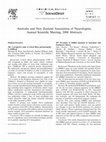
Journal of Clinical Neuroscience, 2007
Background: Critical illness polyneuropathy (CIP) is well recognised in adults and causes muscle ... more Background: Critical illness polyneuropathy (CIP) is well recognised in adults and causes muscle weakness and wasting with failure to wean from ventilatory support. Childhood CIP is relatively poorly characterised. We undertook a prospective clinical and neurophysiological study of critically ill children in order to determine the frequency, nature and severity of neuropathy in such patients. Methods: All children receiving ventilatory support for 72 h or more in the Paediatric Intensive Care Unit of the Children's' Hospital at Westmead were eligible for inclusion if there was no pre-existing neuropathy or myopathy. Data recorded included patient demographics, clinical findings including those suggestive of infection and/or organ failure, medications received, biochemical and haematologic investigations. A standardised electromyographic (EMG), and nerve conduction study (NCS) study protocol was undertaken within 3 days of study enrollment and weekly thereafter whilst the studies remained abnormal or the child remained in PICU. Results: 25 patients were studied. Nerve conduction studies showed a mixed sensory and motor axonal neuropathy consistent with CIP in fifteen children. Abnormalities on NCS were associated with areflexia and loss of proximal muscle strength. NCS parameters remained abnormal on repeat studies in most cases. Conclusion: CIP is common in critically ill children and may be a significant cause of persisting neurologic morbidity in patients requiring ICU management.
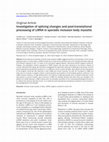
Some features of sporadic inclusion body myositis (s-IBM) suggest that there is acceleration of t... more Some features of sporadic inclusion body myositis (s-IBM) suggest that there is acceleration of the normal ageing process in muscle tissue. LMNA encodes the nuclear lamina proteins lamin A/C through alternative splicing, and aberrant splicing of exon 11 leads to the premature ageing disease, Hutchinson-Gilford progeria syndrome. Progerin, the pathogenic isoform expressed in HGPS tissues, has also been detected at low levels in tissues of normal individuals with aging. We therefore investigated the alternative splicing of LMNA gene transcripts, and the post-translational processing of prelamin A, in s-IBM and control muscle samples. Age-related low level expression of the progerin transcript was detected in both s-IBM and control muscles, but was not increased in s-IBM and there was no increase in progerin protein or demonstrable accumulation of intermediate prelamin isoforms in the s-IBM muscles. However, an age-related shift in the balance of splicing towards lamin A-related transc...
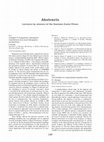
Acta Myologica, 2011
A multidisciplinary referral clinic for the diagnosis and management of adult patients with infla... more A multidisciplinary referral clinic for the diagnosis and management of adult patients with inflammatory myopathy has been in operation at the ANRI in Perth since 1990. Patients are seen jointly by a neurologist, a clinical immunologist and physiotherapist and by a speech pathologist if they have swallowing problems. The diagnosis of myositis is confirmed by muscle biopsy in all cases and screening for muscle-associated and muscle-specific autoantibodies is also performed. Over 250 patients have been seen in the clinic, falling into the following categories: inclusion body myositis (32%), dermatomyositis (32%), overlap syndromes (23%), isolated polymyositis (11%), miscellaneous (2%). Muscle function is monitored by manual muscle testing (MMT) and, in selected cases myometry and isokinetic dynamometry is performed. Patients undergo regular reviews to monitor the response to treatment. This has also allowed observations to be made on the frequency of relapses in patients with dermatom...
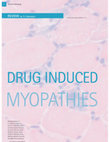
Practical Neurology, 2006
Iatrogenic disorders are an important cause of morbidity, mortality, and admission to hospital. A... more Iatrogenic disorders are an important cause of morbidity, mortality, and admission to hospital. Although drug induced myopathies may be individually uncommon, they are nevertheless an important group of disorders that must be considered when evaluating any patient presenting with muscular symptoms. Their importance lies in the fact that unlike many other neuromuscular disorders they are potentially reversible once the offending agent is withdrawn, whereas failure to recognise their iatrogenic nature will result in unnecessary morbidity and, in some instances, even a fatal outcome. A variety of drugs used in different branches of medicine are potentially myotoxic (table 1), or can cause muscle weakness and fatigue through an effect on neuromuscular transmission or peripheral nerve function.1,2 Some drugs such as the glucocorticoids have a predictable dose related effect and will induce myopathic weakness in any individual treated with sufficiently large doses for long enough. On the ...
Fatigue is a frequently reported complaint in a wide variety of conditions, particularly in disor... more Fatigue is a frequently reported complaint in a wide variety of conditions, particularly in disorders of the nervous system. Two issues complicate the study of fatigue in humans. The first is that fatigue may be defined in a number of ways, depending on the approach taken. From a functional perspective, fatigue can be described as ‘‘a failure in the capacity of the neuromuscular system to generate force or power.’’ 1 Alternatively, fatigue may be expressed in purely subjective terms (‘‘a sustained sense of exhaustion and decreased capacity for physical and mental work’’ 2). This is not purely a semantic issue because it has important implications for measuring fatigue. For the purpose of clarity, the term fatigue is used here primarily in its functional context. Both of these issues are discussed later in relation to findings using transcranial magnetic stimulation (TMS).
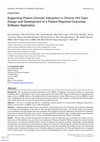
Journal of Medical Internet Research
Background The consideration of health-related quality of life (HRQL) is a hallmark of best pract... more Background The consideration of health-related quality of life (HRQL) is a hallmark of best practice in HIV care. Information technology offers an opportunity to more closely engage patients with chronic HIV infection in their long-term management and support a focus on HRQL. However, the implementation of patient-reported outcome (PRO) measures, such as HRQL in routine care, is challenged by the need to synthesize data generated by questionnaires, the complexity of collecting data between patient visits, and the integration of results into clinical decision-making processes. Objective Our aim is to design and pilot-test a multimedia software platform to overcome these challenges and provide a vehicle to increase focus on HRQL issues in HIV management. Methods A multidisciplinary team in France and Australia conducted the study with 120 patients and 16 doctors contributing to the design and development of the software. We used agile development principles, user-centered design, and ...
Frontiers in Neuroscience
Internal medicine journal, 2017
An 82-year-old woman with polymyalgia rheumatica (PMR) on prednisone 7 mg daily was admitted to a... more An 82-year-old woman with polymyalgia rheumatica (PMR) on prednisone 7 mg daily was admitted to an acute stroke unit with a right homonymous hemianopia, a left posterior cerebral artery occlusion and occipital lobe infarct. She had raised inflammatory markers, did not have a temporal artery biopsy, and was discharged on the same dose of prednisone. After 21 months, off prednisone, her ophthalmologist, concerned about giant cell arteritis (GCA), restarted prednisone 40 mg daily, with rapid, profound visual improvement. After 3 days her general practitioner, noting normal baseline inflammatory markers, stopped treatment-with rapid visual reversion. It is critical to recognise GCA in patients with PMR admitted to a stroke unit and not to withdraw prematurely corticosteroids once commenced.
Electroencephalography and Clinical Neurophysiology
Electroencephalography and Clinical Neurophysiology/Electromyography and Motor Control
Mechler F and Mastaglia F L Adrenergic Regulation of Muscle Blood Flow in Becker S Muscular Dystrophy and Dystrophia Myotonica Ideggyogyaszati Szemle 34 Pp 398 404, 1981
Neuromuscular Disord, 2008
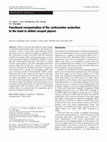
While it is known that relatively rapid changes in functional representation may occur in the hum... more While it is known that relatively rapid changes in functional representation may occur in the human sensorimotor cortex in short-term motor-learning studies, there have been few studies of changes in organisation of the corticomotor system associated with the long-term acquisition of motor skills. In the present study, we have used transcranial magnetic stimulation (TMS) to investigate the corticomotor projection to the hand in a group of elite racquet players, who have developed and maintained a high level of skill over a period of many years, and have compared the findings with those in a group of social players and a group of non-playing control subjects. Increased motor-evoked-potential (MEP) amplitudes and shifts in the cortical motor maps for the playing hand were found in all of the elite players and cortical motor thresholds were reduced in some players, whereas in the social players all parameters were within the normal range. The findings in the elite players are interpreted as being indications of a process of functional reorganisation with the motor cortex or corticomotor pathway that are associated with the acquisition and retention of complex motor skills.

International Journal of Neuroscience, 2016
Purpose/Aim of the study. Poor cardiovascular health, including obesity and altered lipid profile... more Purpose/Aim of the study. Poor cardiovascular health, including obesity and altered lipid profiles at mid-life are linked to increased risk of Alzheimer's disease (AD). The biological mechanisms linking cardiovascular health and cognitive function are unclear though are likely to be multifactorial. This study examined the association between various lipoproteins and cognitive functioning in aging women. We investigated the relationship between readily available biomarkers (i.e. serum lipoprotein) and cognitive decline in domains associated with increased risk of AD (e.g. episodic verbal memory performance and subjective memory complaint). We report cross-sectional data investigating the relationship between serum total cholesterol, triglycerides, high-density lipoprotein (HDL-C) and low-density lipoprotein with verbal memory and learning ability in 130 women with and without memory complaints (n = 71 and 59; respectively) drawn from a study investigating cognitively healthy Western Australians (average age 62.5 years old). After statistical modelling that controlled for the effects of age, depression and apolipoprotein E genotype, HDL-C was significantly associated with better verbal learning and memory performance, specifically short and long delay free recalls (F = 3.062; p < .05 and F = 3.2670; p < .05; respectively). Our cross-sectional findings suggest that the positive effect of HDL-C on verbal memory may be present much earlier than previously reported and provide further support for the role of HDL-C in healthy brain aging. Further exploration of the protective effect of HDL-C on cognitive function in aging is warranted through follow-up, longitudinal studies.

Uploads
Papers by Frank Mastaglia